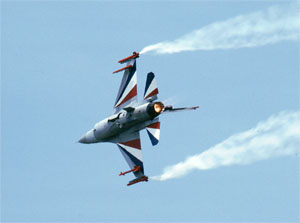A tribute to the F-16

It has now been roughly twenty years that the Royal Netherlands Air Force declared the first squadron equipped with the then General Dynamics, now Lockheed Martin, F-16 operational. Like in three other European countries of Belgium, Denmark and Norway, the type was chosen to replace F-104 Starfighters.
First flown on 2 February 1974, the F-16 evolved from the LWF (Light Weight Fighter) design competition which aimed to develop a fighter in the first place intended for the export market. The United States Air Force at first was lukewarm for the LWF, fearing funding competition for it's main project at the start of the 1970's, the F-15 Eagle. It wasn't until the F-15 was fully established in production that the F-16 was allowed to reach it's full potential. In the end, of course, the F-16 became the USAF's prime tactical fighter. History never repeats itself, but there are parallels with today's F-22 and the Joint Strike Fighter.
Today, the F-16, sometimes known as the Viper or Fighting Falcon, serves in almost every continent apart from Australia, took part in all the major wars since the Cold War ended and proved it's worth in both air-to-air and air-to-ground operations. Not a single F-16 has been lost to enemy fighters to date and with at least a 70 to nil kill ratio, taking on an F-16 in air combat must be as regarded a complicated way of committing suicide. Designed for the air-to-air arena, the F-16 evolved into a capable air-to-ground platform as well. Indeed so well that a new term was invented to describe it's versatility; Swing Role. The F-16 can switch from air defence to ground attack within the same mission, provided the weapons fit allows for this, of course.
Today's F-16C fitted with LANTIRN targeting systems and Laser Guided Bombs are entrusted missions which previously would be performed by much more expensive and less numerous types as the F-111.
Despite a 30 year development life and a 25 year service life, the F-16 spawned only four different versions, F-16A through F-16D, or has it? For political reasons, major changes during the last 15 to 20 years never resulted in a new suffix. Many separate designations is what did happen with e.g. the F-4 Phantom and the F-111. Instead, F-16's are distinguished by Block Numbers. It is no exaggeration to state that the difference between the latest and earliest F-16C is larger than that between the earliest F-16C and the last F-16A. Nowadays' fighters enjoy remarkably long careers. In the 1950's, a fighter was considered obsolete at age 10. Today's F-16's are up to 20 years old and the end is not in sight yet. Indeed, the Mid Life Update is exactly what it is. The F-16 gave the Western European NATO air forces an airplane that transformed those forces from having a limited number of Cold War mission types like interdiction with nuclear weapons and clear wheather air defence to flexible forces, deployable world wide. The F-16 will be a hard act to follow.
On the following pages you will find examples of most of the major Blocks that appeared throughout the years. However, for convenience sake, a division between F-16A/B and F-16C/D has been maintained.
All pictures (c) Hans Rolink.
Beginnings: F-16A/B Block 1 through 20
Maturing: F-16C/D Blocks 25 and beyond
Home

